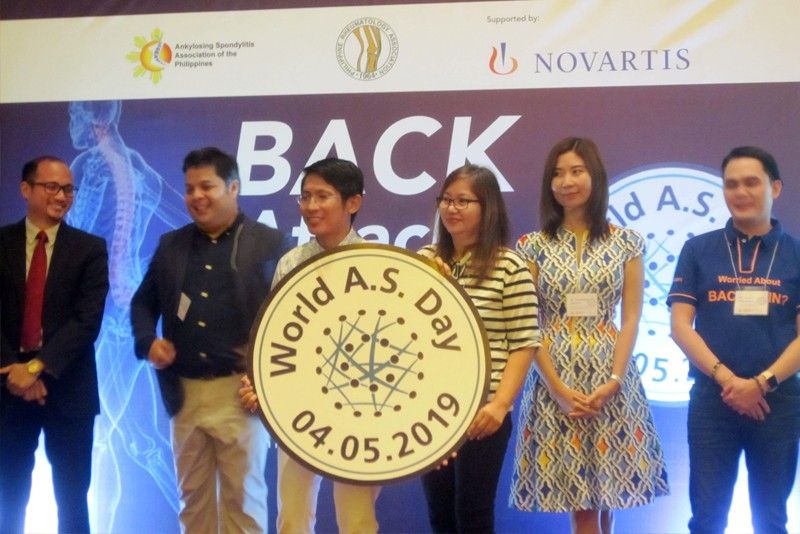Beware: Back attack!

MANILA, Philippines — Many of us experience some form of back pain at certain times. It may be the result of a sedentary lifestyle, perhaps sitting in front of the computer for long hours. Or others may find themselves in a work environment that requires a great deal of heavy lifting, such as construction workers for example.
“Most lower back pains are not serious conditions in origin,” says Dr. Evan Glenn, Vista, board member of the Philippine Rheumatology Association (PRA), “but there is a type of back pain that we have to take seriously.” If the pain lasts more than three months. If you have fever for no particular reason. If you have unexplained weight loss. The pain may go away temporarily when you take pain relievers, but it is even worse when it recurs.
“You might think that it’s just common back pain, but you could have a more serious problem,” Dr. Vista remarks. You may be suffering from a type of arthritis that affects the spine called ankylosing spondylitis (AS), also known as “back attack.” It is an inflammatory condition that affects the joints in your spine. Symptoms include pain and stiffness from the neck down to the lower back.
“AS causes the spine’s bones or vertebrae to fuse together, resulting in a rigid spine. These changes may be mild or severe and may lead to a stooped-over posture. Early diagnosis and treatment helps control pain and stiffness and may reduce or prevent significant deformity,” Dr. Vista explains. “Although it can occur at any age, it most often strikes men in their teens and 20s. It is less common and generally milder in women.”
Clark Ferrer, 33 years old, is a mechanical engineer by profession. He was in his early 20s when he first felt severe pain in his lower hip. He was diagnosed with juvenile arthritis. It took almost seven years and much suffering before he was diagnosed for complications due to AS.
“Back pain has many underlying causes so it is hard to determine if it is AS,” says Dr. Vista. “It’s complicated. Sometimes it takes 10 years since the first symptoms appeared, and by that time, there is damage already. It is a systemic disease that can affect other organs of the body. It is an irreversible progressive disease and it is only now that we are understanding this more.”
There are certain red flags to watch out for. You are less than 45 years old. You experience nocturnal back pain and morning stiffness. It is chronic, lasting for more than three months.It is not infectious.
Genetics is a big factor. But having AS does not mean your children will have it too. You can be a carrier, but not all will develop AS. It has triggers in the environment and new studies are being done in this field.
“It is not rare, but it is underdiagnosed,” says “Dr. Vista. “It is not an exclusive condition. It is common among young adults. It is important to diagnose it early because it affects their most productive years.”
“I could not sleep at night because of the pain,” Ferrer, who is the president of the Ankylosing Spondylitis Association of the Philippines (ASAP) recalls. “I could not move
I had to live with the pain.” He was often irritable. There were times when he did not want to talk to people. He had fears of losing his job, even his family. At one point, he even considered suicide. “It’s hard to live with the pain. We need understanding.” Fortunately, he has a patient and understanding wife.
“It takes a lot of patience,” says Emilia Iriman, who takes care of her husband who also suffers from AS. At first, they thought he was just suffering from stiff neck. Months passed but the pain did not go away. It took more than one visit to more than one doctor, having an MRI and his X-ray taken before he was diagnosed with AS. “I take care of him and give him all my support,” she says. “It can be very tiring, and sometimes we have arguments. But I need to understand that he feels extreme pain. I just need to focus on what he needs.”
Some may resort to massages or acupuncture to ease the pain. “It may give instantaneous relief, but you are just addressing the pain. We have to know the cause. Otherwise the pain will just return and become worse and complications will set in,” says Dr. Geraldine Zamora, member of the patient advocacy committee of the Philippine Rheumatology Association.
Chronic back ache should not be taken for granted. “Early diagnosis and treatment can help prevent worsening symptoms, slow the progression of the disease and delay the onset of other complication,” Dr. Vista remarked.
Raising awareness is important. World Ankylosing Spondylitis Day is observed internationally every year on the first Saturday of May. Advocates worldwide promote awareness and mobilize its supporters. Novartis Healthcare Philippines partnered with the Philippine Rheumatology Association (PRA) and patient group Ankylosing Spondylitis of the Philippines (ASAP) with the aim to connect AS patients with each other and promote awareness for this debilitating disease.



















